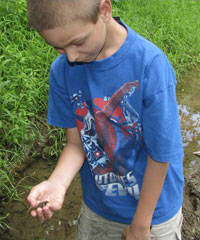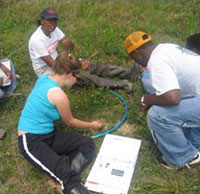 Field investigations are a great way to get students outdoors and conducting science. Field investigations are the systematic collection of data for the purposes of scientific understanding. They are designed to answer an investigative question through the collection of data and communication of results.
Field investigations are a great way to get students outdoors and conducting science. Field investigations are the systematic collection of data for the purposes of scientific understanding. They are designed to answer an investigative question through the collection of data and communication of results.
- Students learn scientific inquiry skills
- Students become systems thinkers
- Students obtain firsthand research experience
- Students learn science doesn’t only happen inside
- Students participate in outdoor experiences which can increase problem solving abilities & motivation
- It’s fun!
Types of Field Investigations:
Descriptive: collect data to describe/quantify
- Question examples: What species of birds can be found in my schoolyard? What plants can be found in my schoolyard?
Comparative: collect data to compare variables
 Question examples: Are the bird species in my schoolyard different from the bird species in the local park? Is there a difference in the plant species that grow in the sun and plant species that grow in the shade?
Question examples: Are the bird species in my schoolyard different from the bird species in the local park? Is there a difference in the plant species that grow in the sun and plant species that grow in the shade?
Correlative: collect data to examine relationships
- Question example: Is there a relationship between temperature and plant growth?
Field Investigation Process:
- Form a researchable question
- Identify research setting
- Identify variable(s) of interest
- Collect data
- Analyze data
- Draw conclusions
- Discuss findings
WILD Field Investigations:
The recently updated WILD guides make conducting field investigations easy for any grade level! The Aquatic WILD guide contains 8 field investigations, 5 of which are expanded and include a list of descriptive, comparative and correlative questions to use with students. The terrestrial WILD guide contains 16 field investigations, 4 of which are expanded. The field investigations are designed to be used in just about any setting from rural to urban and to require the use of minimal materials. Below is a table describing the Aquatic WILD field investigations:
Field Investigation Resources:
Aquatic WILD
 AFWA Field Investigation Guide
AFWA Field Investigation Guide
- An excellent resource that covers the basics of field investigations including sample questions, activities and rubrics
 Photo Point Monitoring: Using Technology in Field Investigations
Photo Point Monitoring: Using Technology in Field Investigations
Cacapon Institute Macroinvertebrate Portal
- This computer-simulated macroinvertebrate program is a great warm up or rainy day alternative to conducting stream studies. Students can virtually sample several streams and can use keys to identify species found within.
Maryland Stream Health Website
- This interactive map helps you find information on the health of streams near you. Streams are color-coded by “health” status, and users can access Maryland Biological Stream Survey data on water quality parameters and species found in stream segments.
Maryland Wildlife Lists with Factsheets
Schoolyard Habitat Identification Resources
Wild Acres: Backyard Wildlife Habitat in Maryland
Photo Acknowledgements:
- Kerry Wixted
- Regional Math and Science Center
For Additional Information, please contact:
Sarah B. Witcher
410-260-8566
[email protected]
Department of Natural Resources
Wildlife and Heritage Service
580 Taylor Avenue, E-1
Annapolis, Maryland 21401
